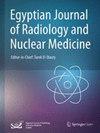人工智能作为乳腺癌筛查双读的初始阅读器:对埃及人口中 32 822 例乳房 X 光照片进行的前瞻性初步研究
IF 0.5
Q4 RADIOLOGY, NUCLEAR MEDICINE & MEDICAL IMAGING
Egyptian Journal of Radiology and Nuclear Medicine
Pub Date : 2024-09-12
DOI:10.1186/s43055-024-01353-5
引用次数: 0
摘要
尽管人工智能(AI)在乳腺癌筛查领域具有潜力,但仍存在一些问题。确保人工智能不会忽略癌症或导致不必要的召回至关重要。这项工作的目的是研究在乳腺癌筛查的乳腺 X 射线照相术常规双读中,人工智能与一名放射科医生结合使用的有效性。研究前瞻性地分析了 32,822 张乳腺 X 光筛查照片。阅片由(i)两名放射科医生和(ii)一名与人工智能配对的放射科医生以盲配方式进行。人工智能为乳房 X 光检查中发现的异常提供热图和异常评分百分比。阴性乳房 X 线照片和未进行活组织检查的良性病变由 2 年随访确认。由放射科医生和人工智能双重读片发现了 1324 个癌症(6.4%);另一方面,由两名放射科医生读片发现了 1293 个癌症(6.2%),相对比例为 1-02(P < 0-0001)。在复查阶段,人工智能和一名放射科医生的组合比两名放射科医生更容易提出怀疑和活检建议。由人工智能和一名放射科医生对乳房 X 光检查进行解读的敏感性为 94.03%,特异性为 99.75%,阳性预测值为 96.571%,阴性预测值为 99.567%,准确性为 99.369%(从 99.252% 到 99.472%)。阳性似然比为 387.260,阴性似然比为 0.060,AUC "曲线下面积 "为 0.969(0.967-0.971)。在常规工作流程中,人工智能可作为乳腺放射摄影筛查评估的初始读片器。人工智能的应用增加了减少假阴性病例的机会,并有助于做出召回或活检的决定。本文章由计算机程序翻译,如有差异,请以英文原文为准。
Artificial intelligence as an initial reader for double reading in breast cancer screening: a prospective initial study of 32,822 mammograms of the Egyptian population
Although artificial intelligence (AI) has potential in the field of screening of breast cancer, there are still issues. It is vital to make sure AI does not overlook cancer or cause needless recalls. The aim of this work was to investigate the effectiveness of indulging AI in combination with one radiologist in the routine double reading of mammography for breast cancer screening. The study prospectively analyzed 32,822 screening mammograms. Reading was performed in a blind-paired style by (i) two radiologists and (ii) one radiologist paired with AI. A heatmap and abnormality scoring percentage were provided by AI for abnormalities detected on mammograms. Negative mammograms and benign-looking lesions that were not biopsied were confirmed by a 2-year follow-up. Double reading by the radiologist and AI detected 1324 cancers (6.4%); on the other side, reading by two radiologists revealed 1293 cancers (6.2%) and presented a relative proportion of 1·02 (p < 0·0001). At the recall stage, suspicion and biopsy recommendation were more presented by the AI plus one radiologist combination than by the two radiologists. The interpretation of the mammogram by AI plus only one radiologist showed a sensitivity of 94.03%, a specificity of 99.75%, a positive predictive value of 96.571%, a negative predictive value of 99.567%, and an accuracy of 99.369% (from 99.252 to 99.472%). The positive likelihood ratio was 387.260, negative likelihood ratio was 0.060, and AUC “area under the curve” was 0.969 (0.967–0.971). AI could be used as an initial reader for the evaluation of screening mammography in routine workflow. Implementation of AI enhanced the opportunity to reduce false negative cases and supported the decision to recall or biopsy.
求助全文
通过发布文献求助,成功后即可免费获取论文全文。
去求助
来源期刊

Egyptian Journal of Radiology and Nuclear Medicine
Medicine-Radiology, Nuclear Medicine and Imaging
CiteScore
1.70
自引率
10.00%
发文量
233
审稿时长
27 weeks
 求助内容:
求助内容: 应助结果提醒方式:
应助结果提醒方式:


